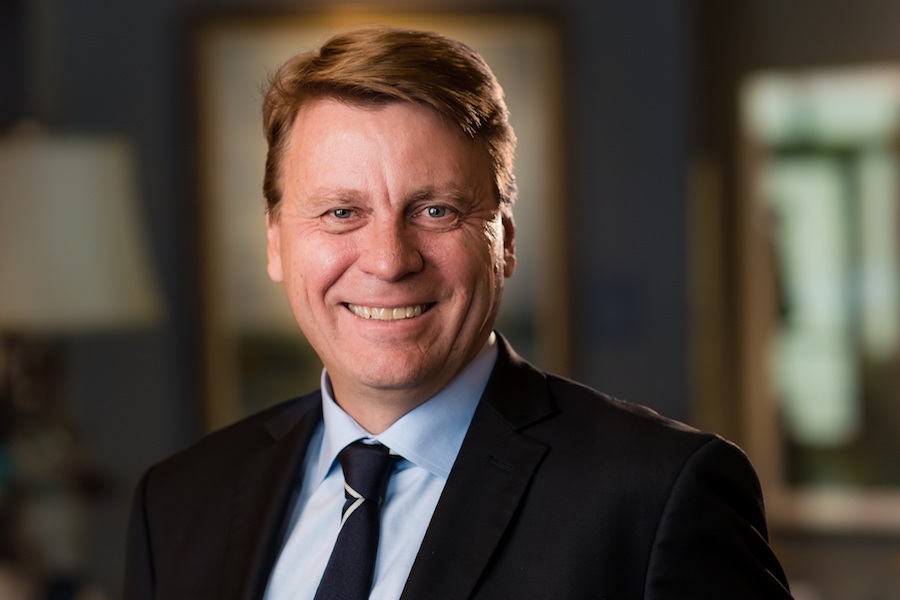
Tom Palmer took the helm at the world’s largest gold miner shortly after bullion had its longest streak of quarterly gains since 2011. Now investors are looking to partake of that windfall.
But before shareholders get their piece of the pie, the new chief executive officer at Newmont Goldcorp Corp. will have to face the challenge of melding the assets from the recently completed mega-merger with Goldcorp Inc.
Newmont shares have trailed its peers, even with gold’s meteoric rise that took the metal to a six-year high of $1,557.11 an ounce last month. The stock’s rally is just less than a third of the pace of gains posted by its closest rival Barrick Gold Corp., which also sealed a massive merger deal.
Palmer inherited the baton from Gary Goldberg for a company saddled by growing pains as it integrates Goldcorp assets, including Red Lake — the project with the highest production cost in Newmont’s portfolio
“Tom has to bring in the Goldcorp assets and get them up operating to a level that they expected,” Joe Foster, a portfolio manager and strategist at VanEck, said in a telephone interview. With “gold prices at $1,500, this company is going to be generating a lot of cash. I hope shareholders would see the benefits of that, with higher share prices and increasing dividends.”
Palmer, 52, inherited the baton from Gary Goldberg for a company saddled by growing pains as it integrates Goldcorp assets, including Red Lake — the project with the highest production cost in Newmont’s portfolio. Those challenges dragged Newmont’s adjusted second-quarter profit to just about half of what analysts were expecting.
“Our focus is to deliver value from our Goldcorp assets through proven methodologies,” Palmer said in a phone interview on Tuesday, his first day on the job. “Newmont has proved itself to be a successful turnaround story, so we’re going to extract value from our existing portfolio based upon that track record.”
Newmont has cut costs by more than a third from their peak in 2013 through early 2016, helping the company navigate through the bear market in gold and putting it in a better position to reap the gains from the ensuing rally in bullion prices.
“Essentially the portfolio is ready,” John Bridges, a New York-based research analyst at JPMorgan Chase & Co., said by phone. “All he has to do is to work through the cost-cutting at their existing operations and use the release of that cash to advance their various projects,” he said of Palmer, who spent two decades at Rio Tinto Group, the world’s second-largest mining company, before joining Newmont.
Foster of VanEck, the fourth-largest Newmont shareholder, is confident Palmer will be a good CEO. “It’s going to be a smooth transition,” Foster said. The portfolio manager is hopeful the company will deliver “not just a token dividend but something substantial with a yield of 2% to 4%.”
In his first interview since assuming the role of CEO, Palmer said the priority for excess cash will be to maintain capital allocation discipline. That means the first focus will be paying down debt, then funding projects, and finally increasing dividends.
Palmer has also been easing back from a plan to sell off assets any time soon. While the company said it would try to sell Red Lake, a mine in Canada, the new CEO has previously said he’s in “no rush” to proceed with the divestment of as much $1.5 billion in assets announced earlier in the year. On Tuesday, he said he plans to maintain flexibility in future M&A.
Palmer may pursue tag-on acquisitions to optimize the portfolio or acquisitions adjacent to land they want to develop, JPMorgan’s Bridges said.
The new CEO has seen the cycles turn. Born in Broken Hill, an inland mining city in New South Wales, Australia, Palmer’s parents, grandparents and great grandparents all worked in the mining industry, according to a Newmont presentation. His daughter, a mining engineer, is set to join the industry next year.
Palmer was named Newmont’s chief operating officer in May 2016. Since the Goldcorp merger, he has played a central role in leading the Goldcorp integration, Newmont said last month, as well as the establishment of a joint venture with Barrick Gold Corp. in Nevada.
“Global uncertainty has made even the generalist investors wanting to have some gold exposure,” Bridges said. “They’re not gold specialists, they just want companies that give them gold exposure and don’t keep them up at night.”
(By Vinicy Chan and Steven Frank)
Comments